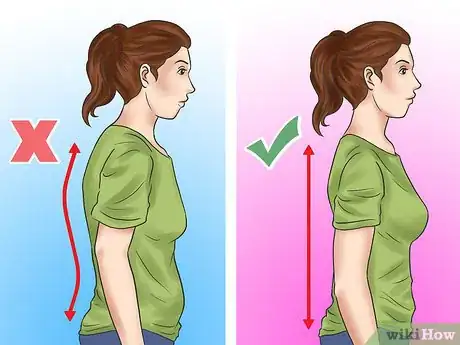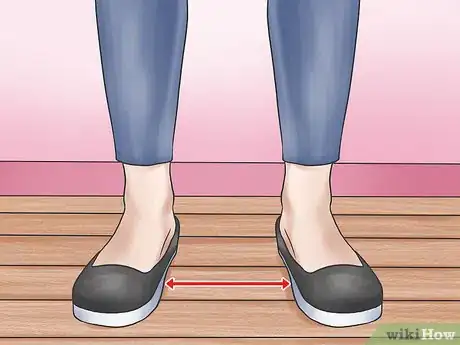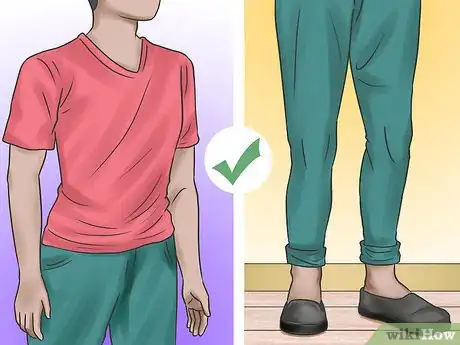This article was co-authored by Annabeth Novitzki. Annabeth Novitzki is a Private Music Teacher in Austin, Texas. She received her BFA in Vocal Performance from Carnegie Mellon University in 2004 and her Master of Music in Vocal Performance from the University of Memphis in 2012. She has been teaching music lessons since 2004.
There are 8 references cited in this article, which can be found at the bottom of the page.
wikiHow marks an article as reader-approved once it receives enough positive feedback. This article received 12 testimonials and 100% of readers who voted found it helpful, earning it our reader-approved status.
This article has been viewed 205,811 times.
Everyone can sing but not everyone can sing well. Much like any other instrument, however, singing beautifully is a matter of learning the right techniques and practicing regularly. With focus, dedication, and attention to detail, anyone can sing beautifully. Beautiful singers have great posture, breathe through their belly, and know how to shape their voice to make gorgeous music.
Steps
Posture
-
1Keep your shoulders back and down. Do not slouch your shoulders forward or hunch them up by your ears. Your posture should be relaxed and confident. Use your shoulders to slightly lift your chest up, making room for your lungs to take in more air. Think of Superman posing triumphantly.
- Don't force this posture unnaturally. Simply focus on keeping your shoulders as far back as possible while still feeling comfortable.
- Lay on your back on the floor to let gravity do the work for you if you find yourself tensing up when trying to maintain the correct posture.
-
2Hold your head level. Your chin should be parallel to the floor. This is essential for keeping the airway in your throat open – looking up or down will constrict your vocal chords and limit your singing ability.[1]Advertisement
-
3Straighten your abdomen. Do not bend forward or backward from the waist. Instead, stand up straight so that your shoulders are above your ankles and your back is relaxed.
-
4Stand with your feet slightly apart, one in front of the other. Your feet should be 6–7 inches (15.2–17.8 cm) apart, with one foot slightly in front of the other. This will keep your weight slightly forward as you sing.[2]
-
5Relax your joints. Keep your knees and elbows loose and slightly bent so that you are not standing rigidly in place. This helps more than just your posture – a relaxed, loose body helps you generate air and control your voice while you sing.[3]
- If you feel tense, sway gently. Or, flop forward as you inhale, then straighten up to reset your posture.
-
6Practice good posture in the mirror. The best way to see your mistakes is in the mirror. Or, you can record yourself singing and watch the video to analyze your posture. Watch yourself from the side and from the front, fixing any mistakes as you see them. You can also practice against a wall—simply stand against it in bare feet, focusing on making your head, shoulders, butt, and heel touch the wall.[4] Remember:
- Shoulders back.
- Chin level with the floor.
- Chest out.
- Stomach flat.
- Joints relaxed.
Breathing
-
1Breathe deeply and evenly when singing. Your normal breathing pattern is shallow and quick because your body does not need as much air as when you are singing. When singing, you need to be able to inhale a lot of air quickly, then exhale it slowly and steadily as you sing.
-
2Use your abdomen for breathing, not your chest. This is the biggest change burgeoning singers need to make when breathing. Think of breathing horizontally, so that your belly expands as you inhale and sucks in and up as you exhale.[5]
- Think of a ring around your stomach and waist expanding as you inhale and contracting as you exhale, moving the air from the bottom of your lungs up to your chest and out your mouth.[6]
- Note how, as you breathe normally, your chest rises and falls. When you sing, however, your chest needs to be still.
- Push your stomach out as you inhale. Put a hand on your stomach. When you inhale, focusing on filling your lower lungs by expanding your stomach as you breathe. Your chest should not move.
- Let your stomach suck back in as you exhale. Again, your chest should not move. As you become more experienced you will feel your back slightly expand out as you exhale.
-
3Practice breathing deeply. You've spent most of your life taking shallow, natural breaths, so you need to practice proper singing breaths to make them a habit. Try the following techniques to perfect your breath:
- Lie on the floor with both hands on your stomach. Inhale through your stomach so your hands rise above your chest, then exhale back to starting position.
- Practice hissing. Hissing requires a steady, thin stream of air. Inhale for 4 counts (1, 2, 3, 4) and then exhale for 4 counts. Then inhale for 6 counts and exhale for 10. Progress with shorter inhalations and longer hissing until you can breathe in for 1 count and exhale for 20.[7]
- The best singers actually use very little air to sing big, loud notes, so take this exercise seriously.
-
4Avoid common breathing mistakes. Because breathing while singing is so different from natural breathing, there are a number of mistakes that beginners make when trying to focus on breathing and singing all at once. Cutting these mistakes will lead to beautiful singing faster. Some to avoid include:
- "Tanking up:" Trying to fill your lungs as much as possible so you don't run out of air. Instead of focusing on having more air, think about exhaling as steadily as possible to preserve your air.
- "Pushing air:" For a beautiful tone, think about letting the air out of your lungs instead of forcing it out.
- "Holding back air:" An advanced mistake, this is when singers stop their voice in between inhaling and exhaling. Focus on breathing “into” your note, silently exhaling air right before starting to sing.
Practicing
-
1Sing from your chest. Most beginning singers feel themselves singing through their throat, and they can feel the pressure in their head and neck as they sing. While this may feel natural, it is the wrong way to sing if you want to sing beautifully. Focus instead on your chest so that you feel it vibrating as you sing. You should feel pressure in your chest as if your voice is coming from your pectoral muscles.
- This is easiest if you are correctly breathing through your abdomen.
- Think of singing from your diaphragm (the muscle under your lungs that controls breathing) if you are having trouble singing from your chest.
-
2Aim to make your voice sound clear and resonant. Typically, beautiful singing is both “clear” and “resonant.” Everyone has a different definition of beautiful, but there is some common ground between all the best singers. Think about the singers you admire and the type of music you want to sing, as you develop your beautiful voice.
- "Clear:" The listener should be able to hear the words and notes without strain.
- "Resonant:" Resonance is the deep, almost subconscious vibrations that all beautiful singers access. Think of the long, powerful, and sustained notes of singers from Aretha Franklin to Luciano Pavarotti.[8]
-
3Learn to hone your “resonators". At the core of beautiful singing is the ability to create resonance, which is when your notes take on a rich, full sound. Listen to any opera singer to hear resonance at its best. Your voice echoes in your chest, mouth, and throat to gain depth. When you are singing with resonance, you feel a slight buzzing or vibrating feeling. To develop resonance, think about your voice's “placement.” Where do you feel the sound coming from? How does it move as you open your lips or move your tongue? Everyone is different, but there are some tips to keep in mind:
- Start by humming a simple “ee” sound. “Move” this noise up and down from your chest to your mouth. These are your resonators.
- Move your tongue down towards your bottom teeth, opening up your mouth and making the biggest space you can.
- Never “swallow” your vowels, or sing from the back of your throat. When you do, they become muddied and unclear.
- If you need help, use a spectrometer or an app like SpectrumView to determine how much resonance you have.
-
4Sing songs within your range or comfort zone. Some people are not comfortable singing high-pitched songs, no matter how much they practice. Others feel most at home in the upper register singing soprano parts. Through careful practice you can find your range, which is the series of notes that you sing most comfortably.
- Sing the lowest note you can without cracking or creaking. This is the bottom of your range.
- Sing your highest note without cracking or creaking. This is the top of your range.
- Your singing range includes all of the notes in between this upper and lower limit.
-
5Hire a voice teacher for personalized, guided advice. This is essential for the burgeoning singer because there is only so much you can learn on your own. Voice teachers know mechanics, music theory, and how to diagnose problems you can't hear yourself. Your voice sounds different to you than to other people, so an experienced guide is necessary to truly sing beautifully.[9]
- Meet with at least 3 voice teachers before choosing one.
- Your teacher should make you feel comfortable and have either extensive performing experience or a degree in vocal training.
- Work with your voice teacher to set and achieve clear goals.
Preparation
-
1Warm-up before singing. Just like an athlete needs to prepare their muscles, a singer needs to warm up their voice to prevent strain and injury. Don't start with a song, or even vowels and consonants. Instead, run through some scales with simple sounds and breaths. Exercises for your warm-up include:
- Hum. Humming activates your breath without straining your vocal chords.
- Trill your lips and tongue to warm up your mouth and jaw.
- Begin with a simple scale, going up and down slowly (doh – mi – sol – mi – doh).
- Begin with the easiest songs you are going to practice, waiting 10-15 minutes to tackle the tougher parts.
-
2Stay hydrated. Vocal chords flap and vibrate to create sound, and they need to be properly lubricated to move freely. Drink 4-6 glasses of water a day and keep a full water bottle near you when practicing. On the night of a concert, make sure that you drink water throughout the day and before performing.
- Make sure you start drinking at least 30 minutes before performing so that your body has time to absorb the water.
-
3Get plenty of sleep. You need to feel well-rested to focus on your singing technique and prevent vocal fatigue or injury. Adults should get 6-8 hours of regular sleep each night in order to sing as beautifully as possible.
-
4Avoid large amounts of alcohol, caffeine, and dairy. Alcohol and caffeine dry out your throat, causing you to strain as you sing. Eating or drinking a lot of dairy products promotes the creation of mucous, which can inhibit proper breathing techniques.
-
5Try not to yell. Yelling strains your voice by forcing air violently through your vocal chords. Speak softly whenever possible to protect your voice when you need it.
-
6Avoid smoking. Smoking damages the tissue in your lungs and should be avoided at all costs. There are few things that can do more permanent damage to your beautiful singing voice than smoking.
Community Q&A
-
QuestionHow do I keep my voice beautiful when singing high notes?
 Lord_TommoCommunity AnswerMake sure you are staying in your range. If it's starting to get uncomfortable to sing high or it isn't sounding right, stop. You may be able to sing a lot higher than your range, but if you do, you will damage your vocal cords. Try and support your chest and breathe from your diaphragm, singing to a distance.
Lord_TommoCommunity AnswerMake sure you are staying in your range. If it's starting to get uncomfortable to sing high or it isn't sounding right, stop. You may be able to sing a lot higher than your range, but if you do, you will damage your vocal cords. Try and support your chest and breathe from your diaphragm, singing to a distance. -
QuestionI think I'm a pretty average singer, but some people tell me I have a beautiful voice and some say I need a lot of work. How can I tell if I'm good or not?
 Community AnswerI think that you should go with what other people tell you, but what you think counts too. If you keep practicing, you may have the potential to become a great singer! A voice coach would be a big help.
Community AnswerI think that you should go with what other people tell you, but what you think counts too. If you keep practicing, you may have the potential to become a great singer! A voice coach would be a big help. -
QuestionCan I still sing beautifully if I'm sick?
 Community AnswerIt depends on the sickness. If you have a headache, body aches, or chills, then yes. If you're experiencing a stuffy nose or sore throat though, then unfortunately, your voice will probably be negatively affected.
Community AnswerIt depends on the sickness. If you have a headache, body aches, or chills, then yes. If you're experiencing a stuffy nose or sore throat though, then unfortunately, your voice will probably be negatively affected.
Warnings
- If you feel pain in your voice, stop singing and see a doctor to prevent series injuries to your vocal cords.⧼thumbs_response⧽
References
- ↑ http://cmed.faculty.ku.edu/gummposture/posture.html
- ↑ http://www.vocalist.org.uk/posture_exercises.html
- ↑ http://www.vocalist.org.uk/posture_exercises.html
- ↑ http://cmed.faculty.ku.edu/gummposture/posture.html
- ↑ http://www.vocalist.org.uk/breath_control.html
- ↑ http://www.bbc.co.uk/sing/learning/breathing.shtml
- ↑ http://www.bbc.co.uk/sing/learning/breathing.shtml
- ↑ http://beautifulsinging.com/singing/tracheal.php
- ↑ http://www.bbc.com/future/story/20130913-why-we-hate-hearing-our-own-voice
About This Article
If you’d like to sing beautifully, start by standing straight with your chin parallel to the floor to prevent your vocal chords from constricting. Then, breathe deeply and evenly as you sing, making sure to breathe from your abdomen in order to make your voice clear and resonant. To make your voice even more resonant, try moving your tongue down towards your bottom teeth to create a larger space in your mouth. Additionally, make your voice powerful by singing from your chest so that you feel the pressure in your pectoral muscles rather than your throat. For more advice from our Music reviewer, including how to warm up before you sing, keep reading.
































-Step-5-Version-2.webp)
















































